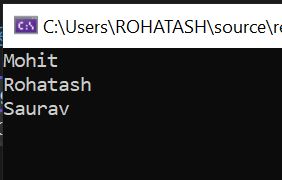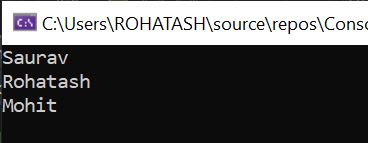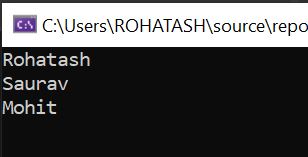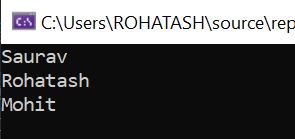LINQ Ordering Operators
In LINQ, you can order results using the OrderBy, OrderByDescending, ThenBy, and ThenByDescending m methods. These methods allow you to sort collections based on one or more criteria. Here's an overview of each operator:
- OrderBy
- OrderByDescending
- ThenBy
- ThenByDescending
- Reverse
Here are examples to demonstrate their usage.
1. OrderBy Operator
In LINQ, OrderBy Operator is used to sorts the elements of a sequence in ascending order according to a key.
Example
using System;
namespace FirstProgram
{
public class Person
{
public string FirstName { get; set; }
public string LastName { get; set; }
}
class Program
{
static void Main(string[] args)
{
List<Person> people = new List<Person>
{
new Person { FirstName = "Rohatash", LastName = "Kumar" },
new Person { FirstName = "Mohit", LastName = "Singh" },
new Person { FirstName = "Saurav", LastName = "Kumar" }
};
// Order by LastName in ascending order
var orderedByLastNameAsc = people.OrderBy(p => p.FirstName).ToList();
foreach (var person in orderedByLastNameAsc)
{
Console.WriteLine(person.FirstName);
}
Console.ReadKey();
}
}
}Output

2. OrderByDescending Operator
In LINQ, OrderByDescending Operator is used to sorts the elements of a sequence in descending order according to a key.
Example
using System;
namespace FirstProgram
{
public class Person
{
public string FirstName { get; set; }
public string LastName { get; set; }
}
class Program
{
static void Main(string[] args)
{
List<Person> people = new List<Person>
{
new Person { FirstName = "Rohatash", LastName = "Kumar" },
new Person { FirstName = "Mohit", LastName = "Singh" },
new Person { FirstName = "Saurav", LastName = "Kumar" }
};
// Order by LastName in descending order
var orderedByLastNameDesc = people.OrderByDescending(p => p.FirstName).ToList();
foreach (var person in orderedByLastNameDesc)
{
Console.WriteLine(person.FirstName);
}
Console.ReadKey();
}
}
}Output

3. ThenBy Operator
In LINQ, ThenBy Operator is used to performs a subsequent ordering of the elements in a sequence in ascending order.
Example
using System;
namespace FirstProgram
{
public class Person
{
public string FirstName { get; set; }
public string LastName { get; set; }
}
class Program
{
static void Main(string[] args)
{
List<Person> people = new List<Person>
{
new Person { FirstName = "Rohatash", LastName = "Kumar" },
new Person { FirstName = "Mohit", LastName = "Singh" },
new Person { FirstName = "Saurav", LastName = "Kumar" }
};
// Order by LastName, then by FirstName in ascending order
var orderedByLastThenFirstAsc = people
.OrderBy(p => p.LastName)
.ThenBy(p => p.FirstName)
.ToList();
foreach (var person in orderedByLastThenFirstAsc)
{
Console.WriteLine(person.FirstName);
}
Console.ReadKey();
}
}
}Output

4. ThenByDescending Operator
In LINQ, ThenByDescending Operator is used to performs a subsequent ordering of the elements in a sequence in descending order.
Example
using System;
namespace FirstProgram
{
public class Person
{
public string FirstName { get; set; }
public string LastName { get; set; }
}
class Program
{
static void Main(string[] args)
{
List<Person> people = new List<Person>
{
new Person { FirstName = "Rohatash", LastName = "Kumar" },
new Person { FirstName = "Mohit", LastName = "Singh" },
new Person { FirstName = "Saurav", LastName = "Kumar" }
};
// Order by LastName, then by FirstName in desc order
var ThenByDescending = people
.OrderBy(p => p.LastName)
.ThenByDescending(p => p.FirstName)
.ToList();
foreach (var person in ThenByDescending)
{
Console.WriteLine(person.FirstName);
}
Console.ReadKey();
}
}
}Output

5. Reverse Operator
In LINQ, if you want to reverse the order of the elements in a sequence, you can use the Reverse method. This method is used to reverse the order of the elements in a sequence, but it's typically used after an ordering operation if you want to reverse the order of an already sorted sequence.
Example
using System;
using System.Collections.Generic;
using System.Linq;
public class Program
{
public static void Main()
{
var people = new[] { "Rohatash", "Rahul", "Mohit", "Saurav" };
var resultstring = people.Reverse().ToList();
foreach (var m in resultstring)
{
Console.WriteLine(m);
}
}
}
Output

Prev Next
